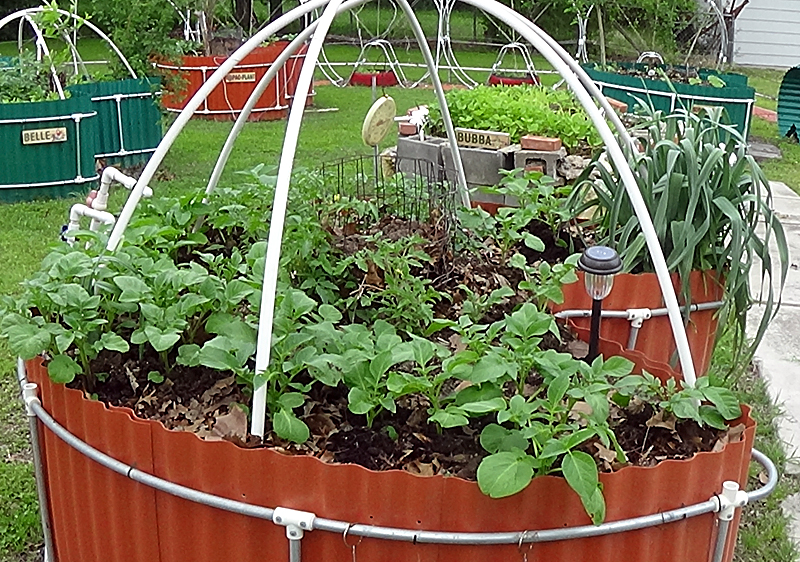
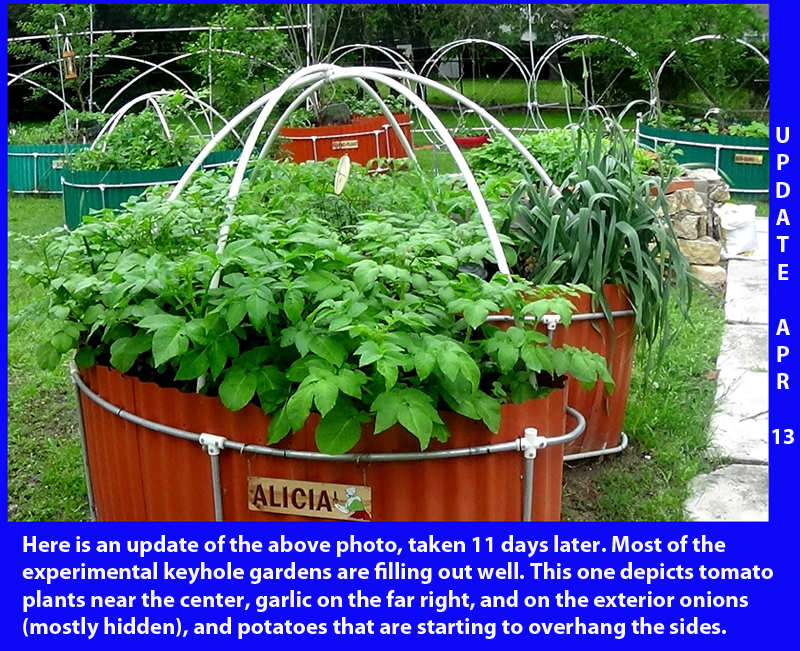 I held my breath this morning (April 2). We had a massive storm and it was predicted we might have baseball-size hail. Luckily, we just had thunder, lightning, high winds, and rain. The plants in my keyhole gardens are looking good — ahead of last year’s schedule, and I didn’t want them damaged.
I held my breath this morning (April 2). We had a massive storm and it was predicted we might have baseball-size hail. Luckily, we just had thunder, lightning, high winds, and rain. The plants in my keyhole gardens are looking good — ahead of last year’s schedule, and I didn’t want them damaged.
I have planted a huge variety of crops. Some are just beginning to show themselves and several are already quite large. This season, the bulk plants include carrots, potatoes, black-eyed peas, early peas, green beans, pumpkins, jalapeno peppers, huge sunflowers (of course), and spinach (to name a few).
About a year-and-a-half ago I planted a very small starter dwarf mulberry tree in my keyhole garden named Lucky. The tree has grown massively compared to the one I planted in the ground at the same time. Currently, it is a loaded with clusters of mulberries (see photo below).
In my garden named Bee Mine (a mini-keyhole kitchen garden), a smaller sunflower has already bloomed.
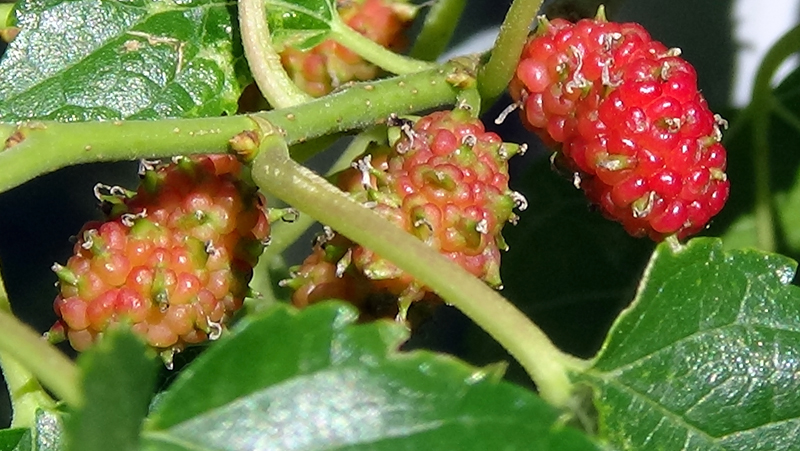
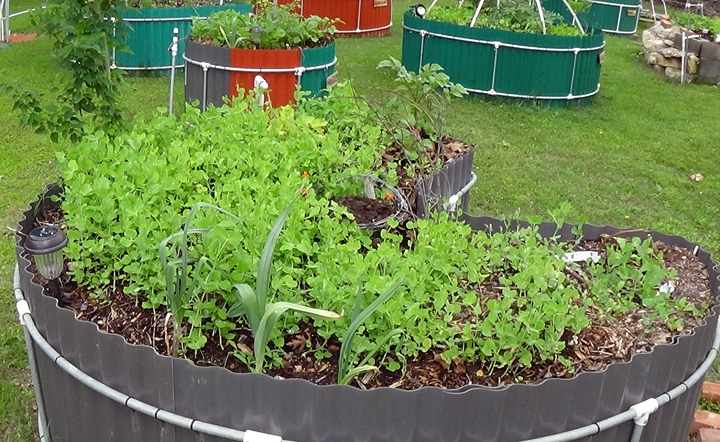 The potatoes I planted in several keyhole gardens are looking splendid and I have already “hilled” them (put extra soil around their base so that the tubers can produce additional potatoes). In the keyhole garden named Pac-Plant (because it looks something like a Pac-man game image from above), I designated about half of it to consist of sand as the main soil. Here is where I planted the carrots in hopes that as the roots are formed they won’t collide with a dirt clod and become misshapen. I also put in a few peanuts here and there to see how they produce.
The potatoes I planted in several keyhole gardens are looking splendid and I have already “hilled” them (put extra soil around their base so that the tubers can produce additional potatoes). In the keyhole garden named Pac-Plant (because it looks something like a Pac-man game image from above), I designated about half of it to consist of sand as the main soil. Here is where I planted the carrots in hopes that as the roots are formed they won’t collide with a dirt clod and become misshapen. I also put in a few peanuts here and there to see how they produce.
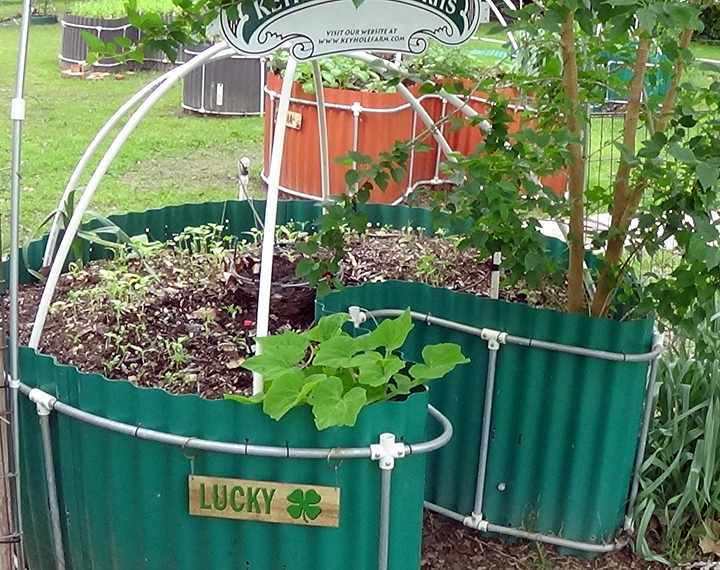 Among my other keyhole garden crops are squash, zucchini, watermelons (several varieties), cantaloupe, okra, melons, gourds, turnips, fava beans, onions, Swiss chard, and many more, including an apricot tree which has leafed out nicely.
Among my other keyhole garden crops are squash, zucchini, watermelons (several varieties), cantaloupe, okra, melons, gourds, turnips, fava beans, onions, Swiss chard, and many more, including an apricot tree which has leafed out nicely.
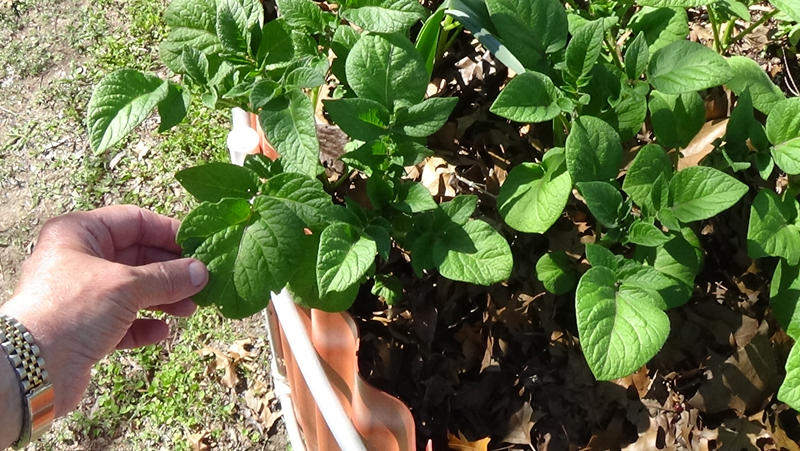 In the keyhole garden named Sun Dawg, several pumpkins were planted. Each day, it is easy to note growth. The “Holy Cow” keyhole garden is where I planted a heavy crop of early peas. It also includes a starter area for blackberries. This particular experimental garden has holes drilled in its side where I have stuffed watermelon seeds in hopes they take off soon.
In the keyhole garden named Sun Dawg, several pumpkins were planted. Each day, it is easy to note growth. The “Holy Cow” keyhole garden is where I planted a heavy crop of early peas. It also includes a starter area for blackberries. This particular experimental garden has holes drilled in its side where I have stuffed watermelon seeds in hopes they take off soon.
In the keyhole garden named Belle, I planted a heavy crop of black-eyed peas. I germinated the seeds in advance to allay the problem with seed rot this early in the season. In my original stone-and-cinder-block garden named Buddy, I planted rows of green beans (pinto and Great Northern) and rows of corn.
My original keyhole garden kit (I believe in its 7th year) is named Alicia after one of my grandmothers who loved gardening. Here, I planted primarily potatoes and tomatoes, with onions around the outer perimeter. It was in Key Rex that I planted the jalapenos, plus a variety of other crops.
I have mentioned this previously. Keyhole gardens are, to me, the perfect gardening system. You control the soil, watering can be limited to the confines of the raised bed garden thereby conserving water, they are easy on the back, weeding is minimal, and the gardener can choose when to harvest their crops, which is important because the “peak time” produces more nourishing crops and enhanced flavor.
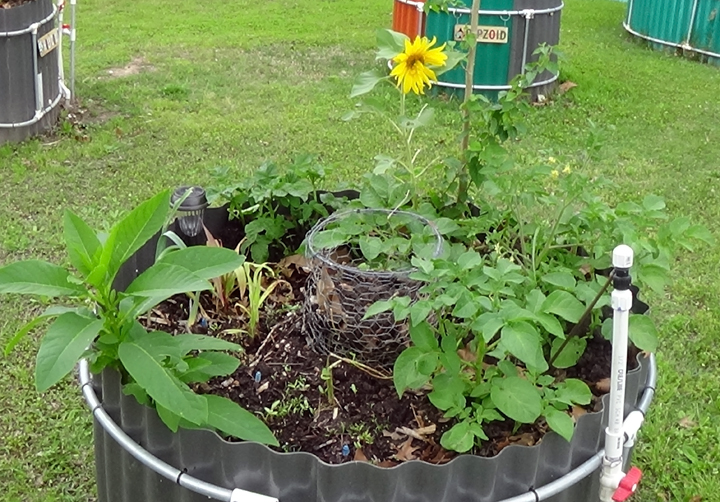
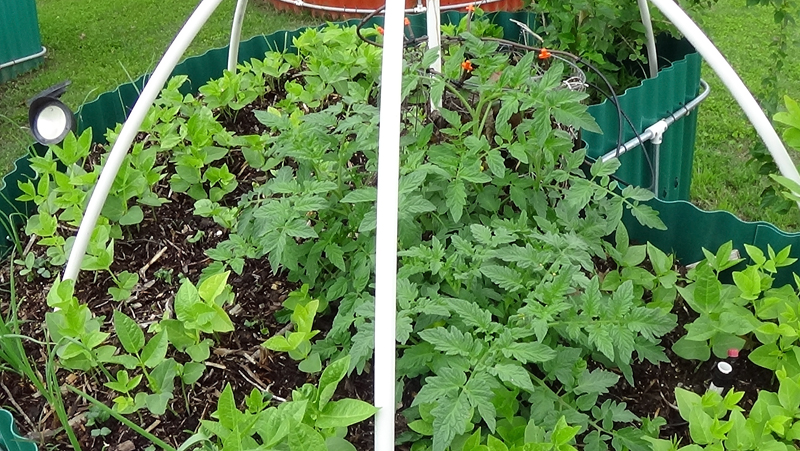 With the internal basket at the center of the keyhole garden, leftovers can be recycled. As they decompose, veggie cuttings, melon rinds, banana peels, tea bags, coffee grounds, plus more provide natural nourishment for the plants inside the gardens and can reduce the need to water, depending upon conditions. Another advantage of keyhole gardens is that seeds can be planted closer together than in traditional gardens, therefore providing many crops. Last year, for a couple of months I spent three hours a day picking green beans. They were extremely abundant in my eleven keyhole gardens.
With the internal basket at the center of the keyhole garden, leftovers can be recycled. As they decompose, veggie cuttings, melon rinds, banana peels, tea bags, coffee grounds, plus more provide natural nourishment for the plants inside the gardens and can reduce the need to water, depending upon conditions. Another advantage of keyhole gardens is that seeds can be planted closer together than in traditional gardens, therefore providing many crops. Last year, for a couple of months I spent three hours a day picking green beans. They were extremely abundant in my eleven keyhole gardens.
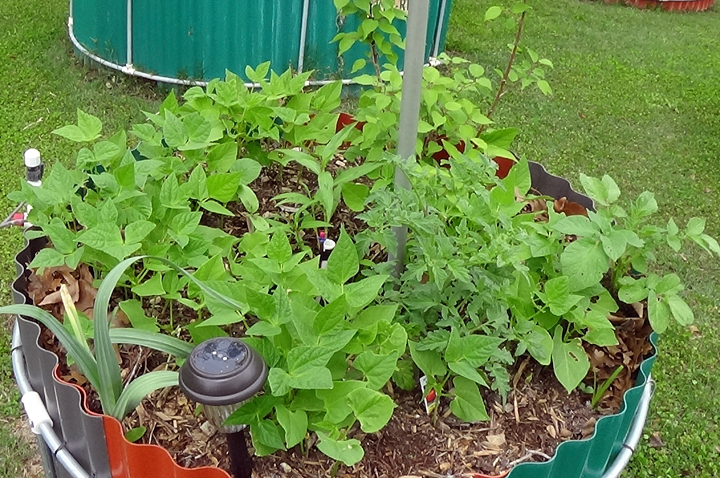 One of the beauties of keyhole gardening is that it’s never too late to start. Some crops prefer springlike weather, while others like it hot. Many prefer cooler weather (like herbs, for instance). It can become a year-round activity filled with experimentation and huge, delicious crops.
One of the beauties of keyhole gardening is that it’s never too late to start. Some crops prefer springlike weather, while others like it hot. Many prefer cooler weather (like herbs, for instance). It can become a year-round activity filled with experimentation and huge, delicious crops.
There is a link on this page if you are interested in obtaining a keyhole garden kit that we designed several years ago. They are lightweight, durable, and fairly easy to put together (it takes us a little over an hour, give or take).
Click on the images on this page to enlarge them some, then click again to return their size to smaller.